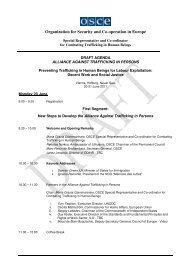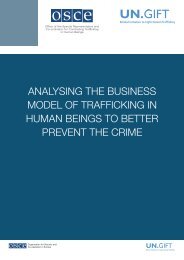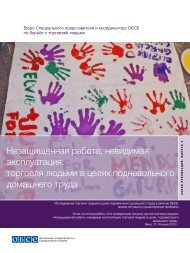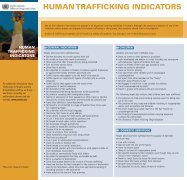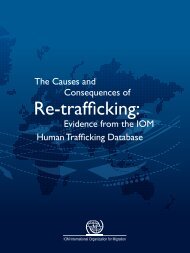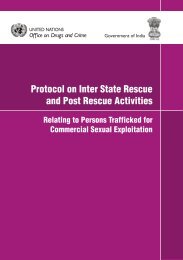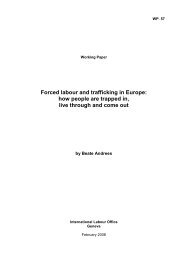An Introduction to Human Trafficking - United Nations Office on ...
An Introduction to Human Trafficking - United Nations Office on ...
An Introduction to Human Trafficking - United Nations Office on ...
Create successful ePaper yourself
Turn your PDF publications into a flip-book with our unique Google optimized e-Paper software.
AN INTRODUCTION TO HUMAN TRAFFICKING: VULNERABILITY, IMPACT AND ACTION<br />
with the HIV virus. 11 These findings dem<strong>on</strong>strate the need for increased attenti<strong>on</strong> <str<strong>on</strong>g>to</str<strong>on</strong>g> HIV<br />
am<strong>on</strong>g young victims of sex trafficking in research and practice. It is difficult <str<strong>on</strong>g>to</str<strong>on</strong>g><br />
determine the absolute rates of HIV infecti<strong>on</strong> am<strong>on</strong>g trafficked pers<strong>on</strong>s and little research<br />
has been d<strong>on</strong>e <str<strong>on</strong>g>to</str<strong>on</strong>g> determine whether these rates are higher than those of n<strong>on</strong>-trafficked<br />
prostituted women or than those in the general community. 12<br />
C.—Mental health impact<br />
Relentless anxiety, insecurity, fear and physical pain and injury will have significant effects<br />
<strong>on</strong> the mental health and well-being of trafficked victims. Symp<str<strong>on</strong>g>to</str<strong>on</strong>g>ms of psychological trauma<br />
reported by trafficked pers<strong>on</strong>s include post-traumatic stress disorder, anxiety, depressi<strong>on</strong>,<br />
alienati<strong>on</strong> and disorientati<strong>on</strong>. These individuals report feelings of extreme sadness<br />
and hopelessness about the future. 13 They may be suicidal, have cognitive impairment and<br />
memory loss, and may be withdrawn. They may also have difficulty c<strong>on</strong>centrating and<br />
show aggressi<strong>on</strong> and anger. Studies indicate that trauma worsens throughout the durati<strong>on</strong><br />
of the trafficking process. Initial trauma comm<strong>on</strong>ly experienced either before they were<br />
trafficked or when they first discovered that they were trafficked, will be c<strong>on</strong>tinually<br />
increased by the process of the trafficking. The l<strong>on</strong>ger victims remain under the c<strong>on</strong>trol<br />
of their traffickers, the more severe and l<strong>on</strong>g-lasting are the effects of their trauma. The<br />
symp<str<strong>on</strong>g>to</str<strong>on</strong>g>ms may persist for a l<strong>on</strong>g time after the trafficking experience unless support and<br />
appropriate counselling is provided. 14<br />
D.—Child victims<br />
Child victims of trafficking are subject <str<strong>on</strong>g>to</str<strong>on</strong>g> the same harmful treatment as adults. Their age<br />
makes them even more vulnerable <str<strong>on</strong>g>to</str<strong>on</strong>g> the harmful c<strong>on</strong>sequences of abusive practices.<br />
Prol<strong>on</strong>ged abuse in children, including physical and sexual abuse, hunger and malnutriti<strong>on</strong>,<br />
may lead <str<strong>on</strong>g>to</str<strong>on</strong>g> permanent stunting of growth. Trafficked children may suffer, for example,<br />
from poorly formed or rotting teeth and may experience reproductive problems at a later<br />
date. The Internati<strong>on</strong>al Labour Organizati<strong>on</strong> (ILO) has documented that children in some<br />
tropical regi<strong>on</strong>s are at high risk of sunstroke, increased heart rhythm, pois<strong>on</strong>ing due <str<strong>on</strong>g>to</str<strong>on</strong>g><br />
chemicals in insecticides, dust inhalati<strong>on</strong> in sawmills and mines, machinery accidents,<br />
burns, road accidents, stagnati<strong>on</strong> of growth and general fatigue that makes them less<br />
resistant <str<strong>on</strong>g>to</str<strong>on</strong>g> malaria and other diseases because of their exposure <str<strong>on</strong>g>to</str<strong>on</strong>g> harsh working<br />
c<strong>on</strong>diti<strong>on</strong>s. 15<br />
11<br />
J. G. Silverman and others, “HIV prevalence and predic<str<strong>on</strong>g>to</str<strong>on</strong>g>rs am<strong>on</strong>g rescued sex-trafficked women and girls in<br />
Mumbai, India”, Journal of Acquired Immune Deficiency Syndromes, vol. 43, No. 5 (2006), pp. 588-593.<br />
12<br />
Paul Williams, “Sex work, the Palermo Pro<str<strong>on</strong>g>to</str<strong>on</strong>g>col and HIV/AIDS”, paper presented by the HIV/AIDS technical<br />
adviser of UNODC <str<strong>on</strong>g>to</str<strong>on</strong>g> the Global C<strong>on</strong>sultati<strong>on</strong> <strong>on</strong> HIV/AIDS and Sex Work, Rio de Janeiro,<br />
Brazil, 13 July 2006.<br />
13<br />
Zimmerman and others, S<str<strong>on</strong>g>to</str<strong>on</strong>g>len Smiles: a Summary Report … , p. 18.<br />
14<br />
Ekaterina V. Shkurkin, “The c<strong>on</strong>sequences of the sexual abuse in human trafficking”, paper presented at <str<strong>on</strong>g>Human</str<strong>on</strong>g><br />
<str<strong>on</strong>g>Trafficking</str<strong>on</strong>g> C<strong>on</strong>ference, Riga, 5 December 2004 (see http://homepages.stmartin.edu/fac_staff/kshkurkin/<br />
C<strong>on</strong>seq%20of%20Hum%20traffic%20with%20inserts%2025feb05.doc).<br />
15<br />
Kathleen Fitzgibb<strong>on</strong>, “Modern-day slavery? The scope of trafficking in pers<strong>on</strong>s in Africa”, African Security Review,<br />
vol. 12, No. 1 (2003) (see www.iss.co.za/Pubs/ASR/12No1/EFitz.htmlHigh profits, low risk).<br />
84





